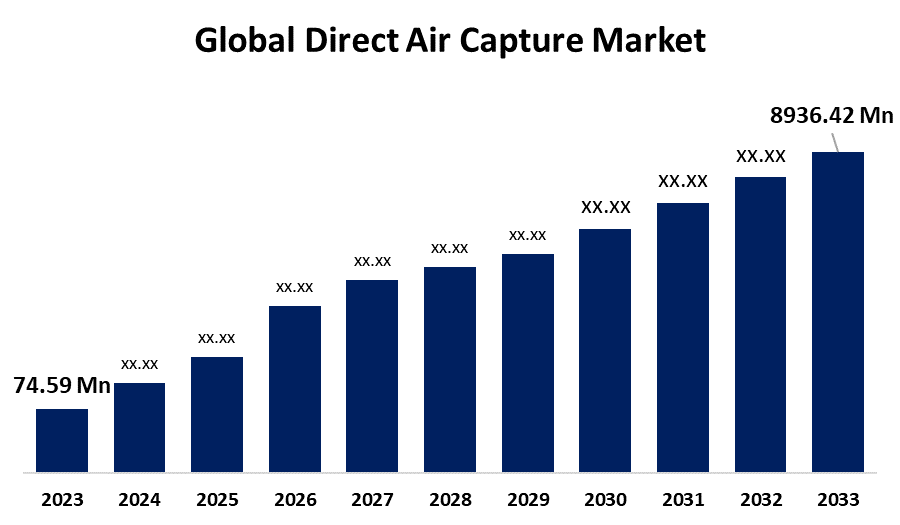Global Direct Air Capture Market Size, Share, and COVID-19 Impact Analysis, By Technology (Solid, Liquid, Electrochemical, and Others), By Application (Carbon Capture & Storage, Carbon Capture, Utilization & Storage, and Others), and By Region (North America, Europe, Asia-Pacific, Latin America, Middle East, and Africa), Analysis and Forecast 2023 - 2033.
Industry: Chemicals & MaterialsGlobal Direct Air Capture Market Insights Forecasts to 2033
- The Global Direct Air Capture Market Size was estimated at USD 74.59 Million in 2023
- The Market Size is Expected to Grow at a CAGR of around 61.38% from 2023 to 2033
- The Worldwide Direct Air Capture Market Size is Expected to Reach USD 8936.42 Million by 2033
- Europe is expected to Grow the fastest during the forecast period.

Get more details on this report -
The Global Direct Air Capture Market Size is expected to cross USD 8936.42 Million by 2033, growing at a CAGR of 61.38% from 2023 to 2033.
Market Overview
The global direct air capture (DAC) market is the sector aimed at technologies for directly capturing carbon dioxide (CO2) from the air through chemical or physical means. Solid sorbents or liquid solvents are the main technologies utilized by DAC systems to capture CO2, which can either be stored permanently in the earth's crust or be used industrially in applications like synthetic fuels, building materials, and enhanced oil recovery (EOR). The market is pushed by climate change mitigation, government policies, carbon credit incentives, and technological innovation that seeks to lower operational costs and enhance efficiency. Furthermore, rising global energy demand is a major driver of the oil and gas industry's growth. As economies grow, particularly in emerging markets, the demand for dependable and affordable energy sources rises. Despite the shift toward renewable energy, oil and gas continue to play important roles in the global energy mix. Transportation, manufacturing, and power generation continue to rely heavily on fossil fuels, resulting in sustained demand for oil and gas products. This ongoing demand encourages investment in exploration, production, and infrastructure, propelling the sector's growth.
Report Coverage
This research report categorizes the direct air capture market based on various segments and regions forecasts revenue growth and analyzes trends in each submarket. The report analyses the key growth drivers, opportunities, and challenges influencing the direct air capture market. Recent market developments and competitive strategies such as expansion, type launch, development, partnership, merger, and acquisition have been included to draw the competitive landscape in the market. The report strategically identifies and profiles the key market players and analyses their core competencies in each sub-segment of the direct air capture market.
Global Direct Air Capture Market Report Coverage
| Report Coverage | Details |
|---|---|
| Base Year: | 2023 |
| Market Size in 2023: | USD 74.59 Million |
| Forecast Period: | 2023-2033 |
| Forecast Period CAGR 2023-2033 : | 61.38% |
| 2033 Value Projection: | USD 8936.42 Million |
| Historical Data for: | 2019-2022 |
| No. of Pages: | 207 |
| Tables, Charts & Figures: | 100 |
| Segments covered: | By Technology, By Application and By Region |
| Companies covered:: | Climeworks, Noya PBC, Global Thermostat (Zero Carbon Systems), Carbyon, Sustaera Inc., Heirloom Carbon Technologies, Carbon Engineering ULC, Avnos, Inc., Soletair Power, CarbonCapture Inc., Skytree, Repair Carbon, and Others |
| Pitfalls & Challenges: | COVID-19 Impact, Challenges, Future, Growth, & Analysis |
Get more details on this report -
Driving Factors
The growth of the direct air capture (DAC) market is driven by the development of carbon utilization and storage infrastructure, which provide viable pathways for captured CO2. Emerging applications for captured carbon, such as synthetic fuels, chemicals, and materials, are gaining commercial traction and attracting industry attention. The expansion of dedicated carbon storage sites and enhanced oil recovery (EOR) operations is increasing demand for DAC-based CO2 supply. Investments in transportation infrastructure, such as CO2 pipelines and shipping logistics, improve the efficiency of carbon distribution across industries. Furthermore, advances in sorbent materials and system design are lowering energy intensity, making DAC operations more sustainable and scalable. Advances in low-energy regeneration techniques, such as electrochemical and membrane-based separation, are increasing capture efficiency while lowering operational costs.
Restraining Factors
One of the primary constraints on the direct air capture (DAC) market is the high operational cost, which is primarily due to energy-intensive processes. DAC systems require more energy to capture CO2 from the atmosphere, compared to point-source capture technologies used in industrial processes. This energy demand frequently results in higher operational costs, making DAC less economically attractive.
Market Segmentation
The direct air capture market share is classified into technology and application.
- The liquid segment held the greatest share in 2023 and is anticipated to grow at a significant CAGR during the forecast period.
Based on the technology, the direct air capture market is divided into solid, liquid, electrochemical, and others. Among these, the liquid segment held the greatest share in 2023 and is anticipated to grow at a significant CAGR during the forecast period. The growth can be attributed to its high CO2 capture efficiency, scalability, and applicability for industrial-scale processes. Liquid-phase DAC systems utilize chemical solvents like potassium hydroxide to capture CO2, then regenerate through a heat-powered process. These systems are widely used owing to their proven success in large-scale facilities and continuous development that seeks to lower energy usage.
- The carbon capture & storage segment accounted for the majority of the share in 2023 and is estimated to grow at a remarkable CAGR during the projected timeframe.
Based on the application, the direct air capture market is divided into carbon capture & storage, carbon capture, utilization & storage, and others. Among these, the carbon capture & storage segment accounted for the majority of the share in 2023 and is estimated to grow at a remarkable CAGR during the projected timeframe. This is due to government regulations and corporate commitments to net-zero emissions are driving this dominance, with a focus on removing CO2 from the atmosphere permanently. CCS involves capturing and storing CO2 in deep geological formations to prevent re-entry into the atmosphere. The growing adoption of large-scale DAC projects, aided by financial incentives and carbon credit mechanisms, fuels the CCS segment's growth.
Regional Segment Analysis of the Direct Air Capture Market
- North America (U.S., Canada, Mexico)
- Europe (Germany, France, U.K., Italy, Spain, Rest of Europe)
- Asia-Pacific (China, Japan, India, Rest of APAC)
- South America (Brazil and the Rest of South America)
- The Middle East and Africa (UAE, South Africa, Rest of MEA)
North America is anticipated to hold the largest share of the direct air capture market over the predicted timeframe.

Get more details on this report -
North America is anticipated to hold the largest share of the direct air capture market over the predicted timeframe. North America's DAC market is facilitated by a confluence of advancements in technology, huge investments, and favorable policy regimes. It has a good infrastructure that ensures the deployment and scalability of the DAC technologies. It is further influenced by hefty government funding as well as tax credits for decarbonization aimed at lowering emissions and achieving climate objectives. The United States and Canada have launched several initiatives, including tax credits and grants, to promote the development and commercialization of DAC solutions. North American companies are also increasingly investing in DAC as a part of their sustainability initiatives to reduce their carbon footprint. The region's availability of top technology providers and research institutions also speeds up innovation and adoption of DAC technologies. As policies to address climate become more stringent and the demand for carbon elimination technologies increases, North America has the potential to continue its dominance in the DAC market.
Europe is expected to grow at the fastest CAGR growth of the direct air capture market during the forecast period. The region has well-established carbon pricing mechanisms and regulatory frameworks that promote investment in carbon-removal technologies. R&D activities are accelerating gains in capture efficiency, cost reduction, and storage solutions. Collaboration among politicians, enterprises, and technology developers is driving market growth. Cross-border carbon storage programs and growing CO2 pipeline networks enable large-scale implementation. The expanding venture capital and investment rounds are expediting the development of breakthrough DAC technologies, allowing for engineering-scale demonstrations, commercial pilot testing, and market expansion for cost-effective carbon removal solutions.
Competitive Analysis:
The report offers the appropriate analysis of the key organizations/companies involved within the direct air capture market along with a comparative evaluation primarily based on their type of offering, business overviews, geographic presence, enterprise strategies, segment market share, and SWOT analysis. The report also provides an elaborative analysis focusing on the current news and developments of the companies, which includes type development, innovations, joint ventures, partnerships, mergers & acquisitions, strategic alliances, and others. This allows for the evaluation of the overall competition within the market.
List of Key Companies
- Climeworks
- Noya PBC
- Global Thermostat (Zero Carbon Systems)
- Carbyon
- Sustaera Inc.
- Heirloom Carbon Technologies
- Carbon Engineering ULC
- Avnos, Inc.
- Soletair Power
- CarbonCapture Inc.
- Skytree
- Repair Carbon
- Others
Key Target Audience
- Market Players
- Investors
- End-users
- Government Authorities
- Consulting And Research Firm
- Venture capitalists
- Value-Added Resellers (VARs)
Market Segment
This study forecasts revenue at global, regional, and country levels from 2023 to 2033. Spherical Insights has segmented the direct air capture market based on the below-mentioned segments:
Global Direct Air Capture Market, By Technology
- Solid
- Liquid
- Electrochemical
- Others
Global Direct Air Capture Market, By Application
- Carbon Capture & Storage
- Carbon Capture
- Utilization & Storage
- Others
Global Direct Air Capture Market, By Regional Analysis
- North America
- US
- Canada
- Mexico
- Europe
- Germany
- UK
- France
- Italy
- Spain
- Russia
- Rest of Europe
- Asia Pacific
- China
- Japan
- India
- South Korea
- Australia
- Rest of Asia Pacific
- South America
- Brazil
- Argentina
- Rest of South America
- Middle East & Africa
- UAE
- Saudi Arabia
- Qatar
- South Africa
- Rest of the Middle East & Africa
Frequently Asked Questions (FAQ)
-
1. What is the CAGR of the direct air capture market over the forecast period?The direct air capture market is projected to expand at a CAGR of 61.38% during the forecast period.
-
2. What is the market size of the direct air capture market?The Global Direct Air Capture Market Size is Expected to Grow from USD 74.59 Million in 2023 to USD 8936.42 Million by 2033, at a CAGR of 61.38% during the forecast period 2023-2033.
-
3. Which region holds the largest share of the direct air capture market?North America is anticipated to hold the largest share of the direct air capture market over the predicted timeframe.
Need help to buy this report?